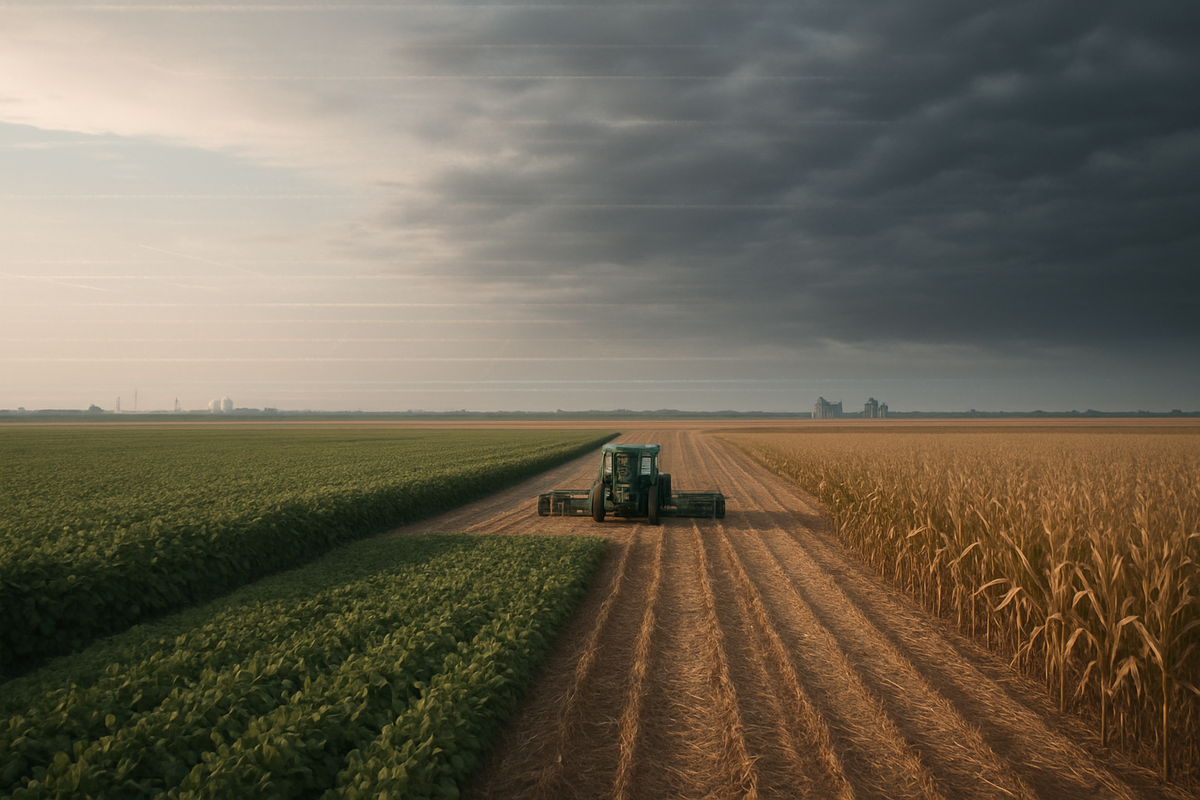
October 17, 2025 - As the autumn harvest draws to a close, the agricultural sector is already looking ahead to the 2026 growing season, with early acreage trends signaling a period of cautious adjustment and potential volatility. Farmers, grappling with the persistent squeeze of high input costs against generally softening commodity prices, are poised to make strategic planting decisions that could reshape the landscape of global food, feed, and fuel markets. These nascent trends, though not yet finalized in official reports, are providing crucial early indicators for investors and industry stakeholders, highlighting a challenging economic outlook for many producers.
The immediate implications of these anticipated shifts are profound. A projected decline in U.S. net farm income, alongside a strategic rebalancing of corn, soybean, and wheat acreage, suggests a market bracing for tighter margins and increased competition. The decisions made in the coming months, influenced by everything from global trade dynamics to evolving climate patterns, will set the stage for agricultural commodity prices throughout 2026 and beyond.
Unpacking the Early Indicators: A Glimpse into 2026 Planting Intentions
As of October 2025, the picture of 2026 planting intentions is being pieced together from farmer surveys, analyst projections, and the prevailing economic climate, well in advance of the U.S. Department of Agriculture's (USDA) official Prospective Plantings report in March 2026. These early indicators suggest a nuanced shift in crop mix, driven primarily by profitability considerations.
The timeline of acreage reporting typically begins with farmer discussions and private analyst surveys during the fall and winter, followed by the USDA's long-term baseline projections around October/November of the preceding year. These baselines offer an initial, albeit non-definitive, outlook. The critical Prospective Plantings report, based on extensive farmer surveys, then provides the first official snapshot in late March, acting as a significant market mover. This is later updated by the Acreage report in June, which details actual planted acres. Throughout the growing season, weekly Crop Progress reports and monthly World Agricultural Supply and Demand Estimates (WASDE) provide continuous updates.
Key players in this ongoing assessment include the USDA, particularly its National Agricultural Statistics Service (NASS) and Farm Service Agency (FSA), which gather and disseminate vital data. Farmers themselves are the ultimate decision-makers, their choices influenced by current and projected commodity prices, input costs (fertilizer, seed, fuel), and agronomic considerations like crop rotation and soil health. Agricultural analysts from firms like UBS and S&P Global Commodity Insights, alongside commodity exchanges such as the CME Group (NASDAQ: CME), play a crucial role in interpreting these trends and facilitating price discovery.
Initial market sentiments for 2026 are characterized by caution. Projections indicate a potential increase in corn acreage, fueled by its relatively favorable price outlook compared to other major crops and its consistent demand for ethanol and livestock feed. Conversely, soybean acreage is widely expected to decline in the U.S., a response to weaker domestic prices, surging global supplies (especially from Brazil), and persistent uncertainty regarding Chinese demand. Wheat acreage may remain flat or see a modest increase, with winter wheat possibly gaining some ground due to export demand, though low prices continue to be a deterrent for significant expansion. Overall, farmers are facing some of the highest production costs in decades, creating a strong impetus to optimize every acre and scrutinize every input expense.
Corporate Crossroads: Who Wins and Who Loses from Acreage Shifts
The anticipated shifts in 2026 acreage trends will undoubtedly create distinct winners and losers among public companies operating within the vast agricultural ecosystem. From input suppliers to grain processors, corporate strategies will need to align with the evolving landscape.
Agricultural Input Companies stand at the forefront of this impact. Seed companies heavily invested in corn and wheat genetics, such as Corteva (NYSE: CTVA) and Bayer AG (ETR: BAYN), are poised to benefit from increased planting of these crops. Higher corn acreage, in particular, drives demand for advanced corn seeds and associated traits, potentially boosting their revenues and profitability. Similarly, nitrogen fertilizer producers like CF Industries Holdings, Inc. (NYSE: CF) and Nutrien Ltd. (NYSE: NTR) are likely to see increased demand, as corn is a nitrogen-intensive crop. Conversely, phosphate and potash fertilizer producers, including The Mosaic Company (NYSE: MOS), may face headwinds if soybean acreage declines, as these nutrients are crucial for soybean growth. Some analysts even project a significant drop in demand for these specific nutrients. Companies providing precision agriculture technologies and digital solutions for optimizing input use will likely see increased adoption as farmers seek efficiency amidst high costs.
The Farm Machinery Sector will also feel the ripple effects. Manufacturers with strong lines of large-scale corn and wheat equipment, such as Deere & Company (NYSE: DE), AGCO Corporation (NYSE: AGCO), and CNH Industrial N.V. (NYSE: CNHI), could see increased demand for planting, cultivating, and harvesting machinery optimized for these crops. However, the overall financial stress on farmers, marked by declining farm income and high input costs, could lead to a general deferral of new equipment purchases, creating a challenging environment for the sector as a whole.
In the Grain Processing Industry, companies like Archer Daniels Midland (NYSE: ADM) and Bunge Global SA (NYSE: BG) are likely to benefit from increased corn and wheat acreage. Higher production of these crops ensures a more stable and potentially abundant supply of raw materials for processing into ethanol, feed, and food ingredients, supporting revenues and profitability. For soybean processors, however, the projected decline in U.S. soybean acreage, coupled with robust global competition, could lead to higher procurement costs or a need to increase imports, creating pressures on their U.S. operations.
Finally, Commodity Trading Firms like Archer Daniels Midland (NYSE: ADM) and Bunge Global SA (NYSE: BG) are generally well-positioned due to their diversified global networks. While U.S. soybean exports may face challenges, these firms can leverage their ability to source and trade commodities from various regions (e.g., Brazil for soybeans) to capitalize on market opportunities. Their global reach and processing capabilities provide resilience in a volatile market, allowing them to adapt to shifts in regional supply and demand. Less diversified traders heavily reliant on U.S. soybean exports, however, could face significant profitability pressures.
Wider Significance: Global Forces Shaping the Future of Agriculture
The early acreage trends for 2026 are not merely statistical shifts but are deeply interwoven with broader, transformative forces impacting the global agricultural landscape. These include the relentless pressures of climate change, the imperative of global food security, and the ever-evolving dynamics of international trade policies.
Climate Change continues to be a dominant factor, increasingly influencing planting decisions. Projections suggest that by 2040, significant portions of U.S. corn and wheat lands could face adverse growing conditions due to rising temperatures and erratic precipitation. This necessitates a shift towards climate-resilient crops and the widespread adoption of adaptive farming practices like regenerative agriculture, which aims to enhance soil health and sequester carbon. Extreme weather events are becoming more frequent, pushing farmers to consider crops better suited to regional climate shifts, potentially leading to long-term changes in cropland allocation.
The ongoing challenge of Global Food Security also plays a critical role. With millions facing acute hunger, acreage decisions become paramount for ensuring a stable and adequate food supply. While agricultural output has grown, the rate has slowed, and per capita food production is strained by population growth and climate impacts. This underscores the importance of bioengineering and diversified cropping systems to enhance resilience and productivity. However, concerns about seed monopolization persist, potentially limiting access to the diverse genetic materials needed for climate adaptation.
Trade Policies are powerful levers in shaping agricultural markets. Changes in tariffs or trade agreements can significantly alter export opportunities, directly impacting farmers' planting intentions. The recently passed "One Big Beautiful Bill Act" (likely referring to the 2025 Farm Bill) aims to bolster U.S. agricultural trade promotion, seeking to expand market access for commodities. Such policies can either incentivize or disincentivize the cultivation of specific crops based on their export potential. The reduced reliance of China on U.S. soybean exports, with Brazil now filling a larger share of that demand, represents a potentially lasting shift in global trade patterns, with ripple effects on U.S. soybean acreage and market strategies.
These acreage shifts also create ripple effects across related sectors. An increase in corn acreage, often linked to biofuel demand, can influence feed costs for livestock producers, potentially impacting retail meat and dairy prices. Government mandates for biofuels continue to shape land use, balancing food and fuel production. Historically, similar periods of policy-driven shifts, like the "Freedom to Farm Act" in the late 1990s or the biofuel expansion in the mid-2000s, demonstrated how policy can dramatically reorient cropping patterns and market dynamics. The current environment, with high input costs and low commodity prices, echoes historical periods of agricultural restructuring, highlighting the sector's vulnerability to economic pressures.
What Comes Next: Navigating the Agricultural Crossroads
The path ahead for the agricultural sector in 2026 and beyond is marked by both persistent challenges and emerging opportunities. Stakeholders from farmers to policymakers will need to adapt strategically to the evolving economic and environmental landscape.
In the short-term (2026 planting season), farmers are expected to prioritize risk management and cost efficiency. The projected sharp decline in net farm income will necessitate careful financial planning, including leveraging enhanced crop insurance options and prudent marketing strategies. The new Farm Bill, with its expanded safety net programs and increased reference prices, will be crucial in providing a buffer against market downturns, influencing planting decisions by mitigating risk. Commodity markets are likely to remain volatile, with geopolitical tensions and trade policy shifts capable of causing rapid price adjustments. Demand for specific inputs will align with acreage shifts, with corn-specific inputs seeing continued demand, while soybean input demand might soften.
Looking to the long-term (beyond 2026), several transformative trends are expected to gain momentum. The shift towards sustainable and regenerative agriculture will accelerate, driven by environmental concerns, long-term cost savings, and consumer demand. This includes practices like no-till farming, cover cropping, and carbon farming, which could open new revenue streams. Technological adoption will be paramount, with increasing investment in bioengineering for climate-resilient crops, agricultural robotics to address labor shortages, and precision agriculture tools leveraging AI and machine learning for optimized resource use. Global trade patterns will continue to diversify, with emerging economies in Asia and Africa increasingly driving demand, while China's role in consumption growth may evolve.
Strategic pivots will be essential for all players. Farmers will need to explore crop diversification, enhance risk management through advanced insurance and forward contracting, and relentlessly pursue cost management and efficiency gains through precision agriculture. Embracing sustainable practices and potentially exploring value-added production can create new revenue streams. Agribusinesses must focus on supply chain resilience, diversify sourcing, and invest heavily in innovation — from bioengineering to agricultural robotics. Identifying and expanding into emerging markets and developing products aligned with sustainable agriculture will be key. Policymakers face the critical task of continuously adapting farm safety net programs, navigating complex trade policies, and investing in agricultural infrastructure and research to ensure long-term food security and competitiveness.
Potential scenarios range from "Cautious Adaptation," where farmers make incremental shifts and leverage existing support systems, to a "Tech-Driven Transformation" where rapid innovation fundamentally alters productivity and profitability. A more pessimistic "Economic Headwinds & Consolidation" scenario could see prolonged low prices and high costs leading to significant financial stress, farm consolidation, and a reorientation towards the cheapest-to-grow crops. Given current economic pressures, the "Cautious Adaptation" scenario appears most plausible for 2026, with all stakeholders navigating a dynamic and challenging environment.
Wrap-Up: Navigating a Tightening Agricultural Economy
The early acreage trends for 2026 underscore a pivotal moment for the U.S. agricultural sector. The overarching narrative is one of a tightening economic environment, characterized by persistently high input costs and a general softening of commodity prices, which is set to significantly squeeze farm incomes. This financial pressure is driving strategic shifts in planting decisions, favoring crops with a more favorable price outlook, such as corn, while prompting a retrenchment in others, notably soybeans.
The agricultural market moving forward will be defined by this delicate balance. While the cattle sector has enjoyed robust returns, row crop producers face increasing financial strain, leading to concerns about rising farm debt. Global factors, including geopolitical events influencing fertilizer markets and evolving trade relations with major importers like China, will continue to exert significant influence. The role of government support, particularly the enhanced safety net provided by the new Farm Bill, will be crucial in mitigating some of the economic pressures faced by farmers.
The lasting impact of these trends points to a prolonged period of adjustment and adaptation. The "paradox of plenty"—where abundant harvests can depress prices—combined with elevated input costs, is pushing many operations to re-evaluate their fundamental strategies. This could accelerate industry consolidation and necessitate a deeper embrace of cost-saving technologies and sustainable farming practices. The structural shift in global soybean trade, with Brazil increasingly supplying China, represents a significant recalibration that will reshape supply chains and demand new market development efforts from U.S. exporters.
For investors, the coming months demand vigilant attention to several key indicators. USDA reports, particularly the Prospective Plantings in March and subsequent WASDE reports, will provide definitive data on acreage and supply/demand dynamics. Input cost trends, especially for energy and fertilizers, will directly impact farmer profitability. The evolving Chinese demand for agricultural products and broader trade relations will remain critical, particularly for soybean markets. Continuous monitoring of global weather patterns in key growing regions will be essential for assessing potential yield impacts. Finally, understanding the nuances of government policy and the implementation of the new Farm Bill will be vital, as these programs provide a crucial safety net and influence planting decisions. Navigating this complex, often volatile, agricultural landscape will require strategic foresight and a keen understanding of both macro and microeconomic forces at play.
This content is intended for informational purposes only and is not financial advice







